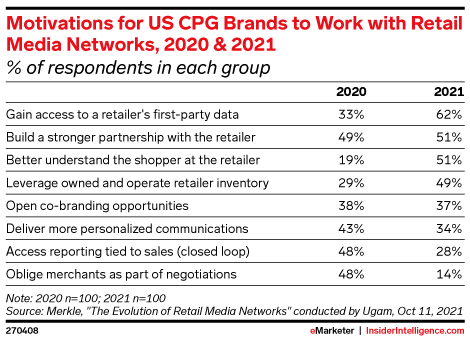Retail media networks (RMNs) have dominated the digital advertising space over the past two years. In fact, eMarketer projects the market will reach $55.3 billion by 2024!
Why the sudden interest? RMNs are proving to be an exceptional strategy for third-party brands because of their VIP access to retailers’ first-party customer data. This allows for more relevant and personalized advertising experiences (a win-win for retailers and brands alike).
Throughout the blog, we will dig deeper into the value and limitations of RMNs.
What is a Retail Media Network?
A retail media network is an advertising infrastructure that allows brands/vendors to purchase space on various online channels (e.g., website, mobile app) to reach their target audience.
RMNs can either be owned by the retailer itself or managed by a third-party service.
In order for a retailer to build their own RMN, they have to have the budget, resources, and data. Because of these restraints, only big-box retailers are investing in this space like Target, Home Depot, Kroger, and Costco.
Smaller, mid-market retailers are relying on third-party services to manage all discussions and purchasing decisions with vendors.
The value of retail media networks
Retail media networks have many benefits for both brands and retailers. Here are a few key highlights from both perspectives:
Brand perspective
-
- Make better-informed decisions on campaigns – Access to first-party data allows marketers to gain valuable insights about purchasing habits, leading to improved future campaigns and events. It also opens a door for more sophisticated targeted advertising that is based on consumer segments.
- Maximize return on ad spend (ROAS) – The first-party data RMNs provides allows brands to push their products in front of shoppers that have a higher likelihood of purchasing.
- Diversification of venues: Brands are able to increase product visibility to shoppers with RMNs. The list of venues has grown for brands to reach their desired audiences, allowing them to invest in endcaps, promos, RMNs, etc.
In a study conducted by Merkle as reported in eMarketer, retail media networks are rising in demand for multiple factors, with retailers’ first-party data access being first on the list.

-
Retail perspective
- Compete on pricing – Retail margins are at a historical low as a result of increased shipping costs and inflation. Having a different revenue stream allows retailers to compete on pricing and encourage repeat purchases as they are being squeezed more and more by rivals’ low prices and free delivery.
- Improved personalization – With access to deeper insights, brands and retailers can further cater to consumer preferences and build a personalized approach that increases customer loyalty.
- Strengthen brand alliances – Retailers that own their own RMN have improved coordination with brands. They are able to align the advertising strategy to ensure they are connecting with the right audience at the right time.
The limitations of retail media networks
Though RMNs drive value in many ways for retailers and brands, that is not to say there are no limitations. Below we discuss the negatives with both third-party RMNs and retailer-owned RMNs:
-
Third-party retail media networks:
Limitations for retailers
While third-party RMNs benefit a mid-level retailer (e.g., lower cost than owning your own, outsource digital ad negotiations), the biggest drawback is the lack of coordination.
Since the third-party service provider is handling all decisions with the vendor, the retailer is left in the dark on what ad spaces are being purchased and by what vendor. This can impact the performance of the ad.
Limitations for brands
Third-party RMNs allow brands to push out their product on more than one retailer’s digital platforms with ease. However, the brand often lacks visibility in what the retailers’ strategy and goals are for their digital platforms. This can negatively impact their ROAS, and result in the brand missing out on richer personalized ads.
Retailer-owned retail media networks:
Limitations for retailers
Limitations for brands
Similar to retailers, brands have to pour more time and energy into working with a particular retailer on purchasing ad space, rather than a third party who is working with many retailers.
This can be especially time-consuming when a brand wants to be represented on many different retailers’ online channels.
According to Marketing Dive, “42% of advertisers report questioning their investments in retail media networks, viewing it as both a valuable advertising tool and a cost of doing business. A lack of both measurement standardization and transparency present additional challenges.”
Coordinating your retail media networks campaigns with promotions
As RMNs continue to evolve, there will be a push for more sophisticated ad strategies to ensure retailers and brands get more from their ad spend.
One way RMN campaigns can improve in performance is by coordinating RMN campaigns with promotions. Aligning on both strategies can improve chances of targeting the right customer, at the right time and place.
Additional benefits of coordinating RMN with Promo:
- Amplify a Product: Spreading a message across all venues can improve chances of reaching your target audience.
- Distribute Ad Spend: It doesn’t always make sense to push a product across all venues. By coordinating, retailers can choose to allocate spending amongst their different venues.
The digital world is evolving fast. Retailers and brands that are slow to adopt the latest solutions and trends will quickly fall behind. However, it is important to understand both the value and limitations of any trend or solution, and make a decision that is best for your business.

